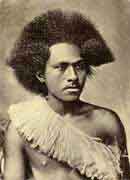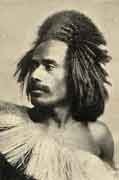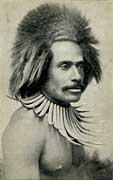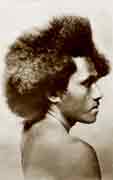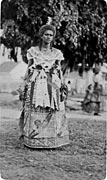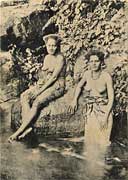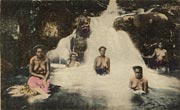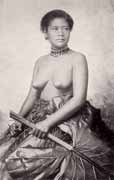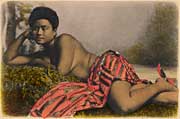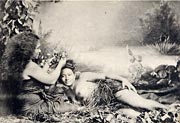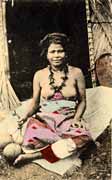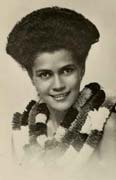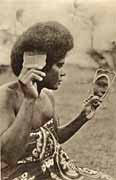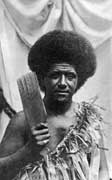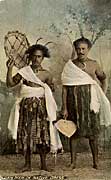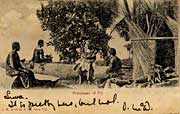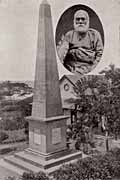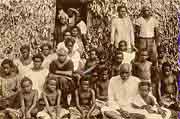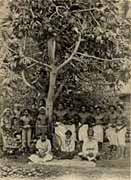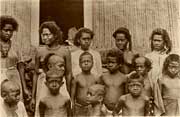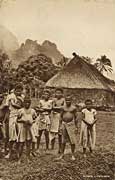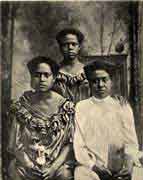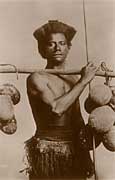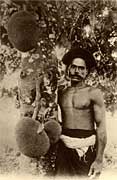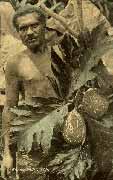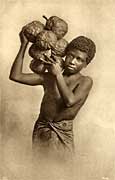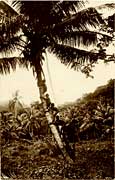 |
"Type of Fijian". Published by Robbie and Company Ltd., General Merchants, Levuka, Fiji. No date, but could have been in the 1880s or 1890s. See note above about connection with Captain David Robbie. The torso ornament worn by this individual is a rather makeshift affair, possibly made quickly for use in a dance. The leaves plaited together were possibly those of the "Ti" plant (masawe or qai in Fijian, bot. Cordyline terminalis). Those worn as formal attire were generally far more elaborate. |
|
"Typical Fijian". Published by Henry Marks & Co. Ltd, Fiji. Unused card. No date, but probably around the turn of the 19th/20th Centuries. This fine-looking man is altogether better presented than the one in the last panel. Not only is his hair carefuly groomed, but his torso ornament or wabale is much more carefully made of teased-out bark of the vau (Hibiscus tileaceus). It was almost certainly made by a woman, using the same general construction as she would have used to plait her own liku girdle. |
|
|
"Typical Fiji Warrior". Published by Gus Arnold, Suva, Fiji. Photographer: John Waters. Unused card. No date, but undivided back and probably around the turn of the 19th/20th Centuries. This fine-looking man has a most distinctively-groomed hairstyle, and wears a similar torso ornament or wabale as the man in the previous image. |
|
|
"Fijian chief". Publisher unknown. Unused card, caption and "P5" and "Copyright" on face under picure. No date, but divided back. The actual photograph was taken by John Waters, probably around 1900. This is the same man as in the previous card, a favourite model of Waters. He wears a beautiful split-whale-tooth gorget, called a wasekaseka, probably one of the studio-props in Waters's studio. |
|
|
"A fine type of Fijian". No publisher stated, but No.9 next to caption on face. Unused card. No date, divided back. Probably about 1920. This man has a full head of hair teased out but not styled as formally as the preceding two men, perhaps indicative of the later date of this picture. Has a sash of white fringed masi over his shoulder. |
|
|
"Type of Fijian 4". Printed by Lilywhite, Ltd., Triangle, England, for F.W.Caine, Suva, Fiji. Guaranteed British manufacture and real photo. Unused and undated, but perhaps somewhere about 1910. Note the change of hair fashion from the earlier styles above. This man's wabale sash is of finely plaited waloa, the blackened roots of an Armillaria plant. Though today, and in most photographs since the late 1800s, sashes are mostly of barkcloth, the term wabale means 'draped vine (or cord),' which might suggest that this type was the original form. Just visible at the bottom of the photo is the end of the handle of a kiakavo club, the Fijian footsoldier's normal weapon, equivalent to the British "Brown Bess". |
|
|
"Groupe (sic.) of Fijians". J.W.Waters, Suva, Fiji #140706. Unused and undated, perhaps about 1910. The standing figure was one of Waters's favourite models. He is seen in other cards on this site, such as on the left as one of the "young warriors" and on the far right as one of the "cannibals". Here he is wearing a sash of Cakaudrove masi over his right shoulder, and copious vesa arm-decorations of vines and flowers. He is holding a kiakavo club, the standard "footsoldier" weapon. The seated man for some reason holds a canoe paddle, while the seated young woman holds an i-iri dance-fan, and wears a red-brown smoked masi kuvui sash. |
|
|
"Bride". No publisher or photographer shown. Real photo postcard, probably 1930s. Though it has not been posted, this card has this comment written on the back: "This Fijian lady is in her wedding dress. Note the plaits [tobe] in her hair that denotes that a girl is single. Her dress is of tapa [barkcloth — actually called masi]." This comment is reasonable enough. Tobe were virgin plaits, cut off by the woman's husband on their wedding night. The woman's skirt is a kumi, a special Tongan-style figured Fijian cloth. In her hair she wears an ornament called tekiteki, that in this case is a stick with barkcloth strips. |
|
|
"Fijian belles 'all dressed up' at Suva, Fiji Islands". No publisher or photographer shown. Numbered on face "I-61". Real photo postcard, probably 1930s. These young women look as though they are dressed to perform a fan-dance (meke ni iri) . The woman on the left holds a dance-fan in her right hand. It is of interest that the women are wearing masi barkcloth from different regions, which shows either that they came from different places or that the cloth was merely bought and was not that of their own vanua. The two on the left have long skirts of Tonga-style barkcloth, both with tiered Fiji barkcloth over them, the uppermost being red-brown smoked masi kuvui, which should only be worn by those of high rank so suggests they are women of a chiefly clan. The middle woman wears an overskirt of fine white masi vulavula as the middle layer in the tiered array. The one on the right wears a piece of Cakaudrove masi kesa, from northeastern Fiji, and the two outer women wear small single shell necklets — itaubebuli. |
|
|
"Fijian Types of Beauty". No publisher or photographer shown. Numbered 5731. Used, 1 penny stamp postmarked July 26 1912. Addressed to C.E.McKenney Esq., McKenny Taylor & Coy, 117 Pitt St, Sydney. Brief message signed "Dal" and dated the day before the postmark. This 'triangulate' hairstyle was in favour with both sexes in the early 20th Century. It replaced close-cropped hair for women and various ornate styles for men in the 19th Century, and was in turn replaced by the 'afro' style as in the picture of the young woman and man combing their hair. |
|
|
"Native women bathing, Fiji". Photographer & publisher Harry Gardiner, Suva, Fiji. Numbered SK2326. Unused and undated, but undoubtedly tamen at the same time and place as the previous photograph. Lithograph, hand-tinted. This is not a well-printed card, and in light of the date on the previous card, which pre-dates Gardiner's work in the field, it is probable he re-used someone else's negative, perhaps Waters. |
|
|
"Fijian Maidens". Publisher: A.M. Brodziak & Co., Suva - Fiji. Unused, undated but probably not later than the first decade of the 20th Century. Text on face of card in red ink and there appears to be slight handtinting though much faded. |
|
|
"Native girl, Lau, Fiji" Unused and undated. Divided back, but probably pre-1910. No publisher given but numbered P3. The huge leaf the girl is holding is from a common wet-area plant (I don't know the name). These were used as umbrellas or parasols. She is wearing a likuwaloa, skirt made from a black creeper and actually a man's ceremonial dress, not a woman's. She is also wearing a beautiful necklace (taube) made of tiny shells. Her hair is worn the length traditional for women in the 19th Century, compared with the styles above and below, but she is not wearing tobe plaits. |
|
|
"Samoan girl". Unused. G.L.Griffith, Suva, Fiji. Handcoloured lithographed card, probably 1920s. As commented above, it was common for postcard sellers in Fiji to use female models from Fiji's Polynesian neighbours because their fairness was considered more attractive to Western eyes than indigenous Fijian women. In this case, however, it could be that a reverse substitution was the case, with a fair-skinned Fijian woman being presented as Samoan precisely because of that preference. It is not impossible that the cropped hair and features of this model belonged to a Samoan, but her features are at least as "Fijian" as those of the girl in the previous picture. |
|
|
"Decorating". Unused. J.W.Waters, Suva, Fiji. Lithographed card, unidivided back so late 1800s or very early 1900s. As commented above, it was common for postcard sellers in Fiji to use female models from Fiji's Polynesian neighbours because their fairness was considered more attractive to Western eyes than indigenous Fijian women. In this case from their fearures the women appear to be Samoans. |
|
|
"Fijian Marama". Publisher Harry Gardiner, Suva, Fiji. Undated and no postmark, but being by Gardiner it would be 1920s. A message is written diagonally across the back, addressed to "Dear Robbie", and signed "Auntie Sarah". From her physical appearance and her wavy rather than frizzy hair, the subject in this photo looks like a Lauan woman. She is wearing a necklet of cord strung with two small white shells, and also a salusalu (what the Hawaiians call a lei) of what looks like plaited leafy vine. She holds three coconut-shell water-bottles (kitu), and is sitting on a finely-woven davodavo daligana sleeping-mat (see Ewins w982, Matweaving in Gau, Fiji, for a description of these and how they are made). |
|
|
"Roma of Fiji". Publisher Co-Operative, No 23. Undated, but the Co-Operative began trading in the early 1930s, and this image probably dates from an earlier date, to judge from the hairstyle, which by the 1930s had given way to the full "Afro" seen in the next picture. This beautiful woman, to judge from her features, may have come from Lau. |
|
|
"Fijian combing hair". Publisher Co-Operative, No.159. Unused and undated, but the Co-Operative began trading in the early 1930s, and this image probably dates from then. Compare with modern image of the same subject. |
|
|
"Fijian and native comb". Publisher Co-Op #38220-N. Unused and undated, but the serial number suggests a date of 1938. This labelling and numbering system post-dates that of the previous image. The man's wabale sash somewhat resembles that worn by the man in the early photograph at the beginning of this page, and like that is more likely to relate to dancing than to a ritual. |
|
|
"Fijian men in native dress". Publisher unknown, Printed in Australia. Hand-tinted. Postally unused, but inscription on back reads: "This is not too good a view in my opinion of Fijian men. That is usually the extent of their costume, some of them wear singlets or shirts though." Undated but perhaps around the turn of the 19th/20th Centuries. The writer's misgivings were justified to the extent that the dress of these men was ceremonial rather than everyday. Each is wearing a waloa skirt worn for warfare and ceremony, and each has a barkcloth wabale sash across his right shoulder. The man of the left also wears an i-oro cummerbund of white masi barkcloth, and holds aloft a war-fan (i-iri masei). He also wears two cock-feathers in his hair, while the other wears an ornamental comb. The latter carries a finely-made "common" fan in his right hand, not an unusual accoutrement of chiefs. Both men wear warriors' boar-tusks on necklets. |
|
|
"An old Fijian cannibal". Unused. Hand-tinted. Publishers: Henry Marks & Co. This popular old personality was known as "Cannibal Tom", though I have not been able to discover his actual name. Here he is wearing a most elaborate wig. The wearing of wigs of human hair was common, but this one is of unusual design, I have seen no museum examples with such an amplitude of ringlets. On his breast is an ornament that is difficult to make out clearly. It is not one of the elaborate ivory and pearlshell civavonovono breastplates that were such a valued item and heirloom object, but it may be a ground-down civa (black-lipped pearlshell) or simply a wooden plate. |
|
|
"Cannibal Tom". Unused. Hand-tinted. Publisher: Henry Gus Arnold, Suva Fiji A full-length picture of the same character, wearing a warrior's liku waloa skirt of blackened vines, and carrying a common kiakavo spur-club. |
|
|
"Princesses of Fiji". A.M.Brodziak & Co., Suva, Fiji. Apparently printed in France, bearing on the reverse a mix of French and English labelling. Addressed to Miss Vera Whiting, Astolab (?), Randwick, Sydney, NSW, Australia. On face is the message "Suva, It is pretty here, but hot. V.M.W." Whether these were indeed nobles is unclear. To this day tourists fondly believe every Fijian they meet to be either a chief or a princess, and this caption may be capitalising on that. Three of the women are of distinctly Tongan appearance, only the woman facing the camera wearing her hair in the Fijian fashion of the day, and a masi barkcloth overskirt over her typical "Polynesian Western" dress.That fact, and the appearance of the lean-to, suggest that this photo may have been taken in a Tongan-influenced part of the Lau Group, perhaps Ma'afu's headquarters, Vanuabalavu. The women appear to be sitting on slit-gongs (lali), but another possibility could be that they are cut-down canoe hulls, such as used for printing Tongan-style ngatu barkcloth. Near the legs of the woman on the left is a papasia wooden bowl used for food preparation in Lau. |
|
|
"King Cakobau & Monument - the last of the Fijian kings". Unused. Published by A.Mills, Suva. Unused and undated, but Mills was working very early in the 20th century, and this card probably dates from the 1890s. This monument was erected in 1889, not on Cakobau's home island of Bau, but within the Government House compound in Suva. The obelisk was paid for by Fijian subscriptins, and the plaques commemorated the Deed of Cesion. Inset is a Dufty portrait of Cakobau in old age. The description of him as "the last of the Fijian kings" is very much a European take on his status, but even by their standards he was arguably the FIRST "king" as such. He was certainly one of the pre-eminent high chiefs of Fiji, but his entitlement to the title "king" rested on his having been crowned by a group of European residents on 2 May 1867, in the church on his home island of Bau. He was not entitled to this pre-eminence by birth, though admittedly following his "coronation" 297 of his fellow chiefs did pledge their alliegance, swearing "to uphold the authority of the King, the constitution, and the laws of Bau" (Derrick A History of Fiji pp.163-4). |
|
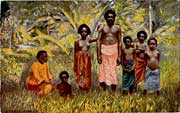 |
"A Fijian Family". Unused. Tuck's Post Card. "Oilette" [Regd.] postcard 7601. Publisher Raphael Tuck & Sons Ltd., By Appointment. Art publishers to Their Majesties the King & Queen. This is another of the group of six that Tuck published, all reproduced on this website. On the reverse is the caption: "The natives of the Fiji group of islands are Melanesian with a stain (sic) of Polynesian blood. They are dark and frizzly haired, and until a few years ago were wild savages and notorious cannibals. The domestic life of the modern Fijian is excellent, and of a high standard, discipline and parental authority being strictly maintained." |
|
"A Fijian family" Publisher: Caine Series #36. Copyright. Undated but probably early 1900s. Unused. "Real photo postcard. British made." |
|
|
"Fiji - Chiefs and natives at the foot of a breadfruit-tree" Publisher: A. Bergeret & Cie, Nancy (France). Unused, undivided back. Undated but before 1900. The most interesting thing about this card is the 'official' trappings of both the chiefs and the commoners. First, all three chiefs wear hairscarves of smoked barkcloth (i-sala kuvui). Then, the chief on the left as we view them holds a flywhisk (i-roi), while the one in the middle holds a chief's warfan (i-iri masei) while around his neck he wears a crucifix on rosary beads, proclaiming him a Catholic. Most of the commoners are carrying weapons befitting their warrior status: The man on the far left of the picture either has limed hair or wears a wig, and appears to be holding a firearm. He also wears a crucifix and rosary beads like his chief; the child behind him holds something but it is impossible to make out; the youth in the checked skirt (i-sulu) holds a large wooden food-pounder (vutu), a male ceremonial gift item; the two youths behind him both shoulder pole clubs, the one on the left a massive boai baseball-bat-shaped club; the youth perched up in the tree also wears a crucifix and holds a small ball-headed throwing club (i-ula drisia) in his right hand; the white-skirted man nearest the tree cradles the head of a larger i-ula drisia in his left hand; the man behind his left shoulder carries a lobed throwing-club (i-ula tavatava); the two men further away from the tree each hold boai; the two men on the far right of the picture also hold ball-headed throwing clubs. Several of the men wear vine and bead vesa upper-arm decorations. |
|
|
"Curious Haircuts". Publisher: Caine Series #36. Unused and undated, but probably pre-1920. The girl in white in the centre back row is wearing "virgin-plaits" (tobe), as are the two on either side of her. But most remarkable are the bizarre haircuts on the small boys standing in front of them. It calls to mind the comment by Commander Wilkes of the US Exploring Expedition in 1838-42: "The women exhibit droll fancies in the cropping of their children's hair, always leaving one long lock, which is well frizzled, and stands out from some part of the head, giving an uncouth appearance to the boy or girl." (Wilkes 1845: 353). This behaviour had certainly totally disappeared by World War 2, and I have never seen any examples of it, though I have in the 1980s seen a number of young women still wearing tobe in remote parts of the Group. |
|
|
"Group of Mountaineers' Children, Fiji". Photographer/publisher: Harry Gardiner. Original Collection: W.J. & R.M. Ewins. Printed in Germany. Undated, but Harry Gardiner visited Namosi in August 1922 and took a series of photographs of which this was one (ref.Stephenson p.52) |
|
|
"Fijan children". Unused, undated. Tuck's Post Card. Publisher Raphael Tuck & Sons Ltd., London. C opyright Fiji Government. Caption reads:"Children in a native village. Some of them are rather over-dressed to face the camera." This is not just a sly dig, but refers to the fact that traditionally it was the norm for Fijian children of both sexes to go naked until the age of puberty, which clearly several of these children are not. |
|
|
"Fijian Belles". Unused, but the date 18th Nov. 1911 has been written in one corner. Edition British & Foreign Imports & Exports - Milan. The two young women left and rear show the height of Fijian "party" fashion of the day, while the one on the right wears the churchy "mother hubbard" worn as Sunday best. |
|
|
"A breadfruit seller, Fiji". No publisher information, but "No 36" on face of card. Printed in England. No date, but this picture is reproduced in the Cyclopedia of Fiji (p.3) published in 1907, so it was certainly taken by that date at the latest. It was also released as "Fijian with breadfruit" #P4, publisher unknown. The photographer has contrived to dress this "hawker" incongruously in a black fibre over-skirt (liku waloa), normally worn in warfare, and he has a javelin spear (motodua) caught by his fingers against the carrying staff. The hairstyle is elaborate, suggesting an early date for the photo. In his hair the man is wearing what appears to be a decorative comb. |
|
|
"Fijian and jackfruit tree". Caine Series #106, Suva, Fiji. British Made, Printed in England L.L.H. Unused and undated. |
|
|
"Bread fruit, Fiji". No photographer or publisher listed. Divided back, hand-tinted card (green hair!?) , probably around 1910s. Undated and used but only as part of a long letter. |
|
|
"Fijian and Papaw tree". Publisher J.W. Waters, Suva, Fiji. Copyright. #72380. Hand-tinted. Undated and unused, but undivided back, probably around 1900. Someone has written in ink below the caption on the face of the card "Mummy apples", the colloquial colonial name for pawpaws. This man is dressed in a dance-skirt and is holding a totokia beaked battle-hammer in his hand. |
|
|
"Giant Fiji lemons". No publisher, but the number 78625 is printed in the lower right corner. Undated. In fact, Elsie Stephenson enlightens us, this photograph was taken in late July 1905 by Bolton Stinson, and originally published by him in the 1912-13 Stinson Studio set of cards, then again in the 1930s in the Co-Operative series. The remarkable fruit were believed to be a hybrid of the rough-skinned Fiji lemon and the shaddock (Stephenson 1997: 21, 22) |
|
|
Boys climbing a coconut palm. Undated, early 20th Century. Printed at Chapmans Levuka Fiji. Kodak postcard. |
